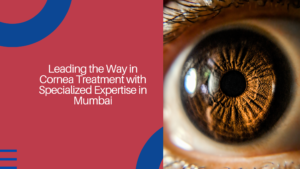What is Cornea?
The cornea is the eye’s outermost translucent layer, placed in the anterior part of the eye. It covers the small aperture of the eye, i.e., the pupil, the visible pigmented region, and the iris. The primary function of cornea is to refract light entering the eyes. In addition, the cornea is responsible for most eyes’ focusing function and optical power.
Proteins and cells make up the cornea. Unlike most other tissues in the human body, it lacks blood vessels. Blood vessels can cloud the cornea, preventing it from properly refracting light and impairing vision.
Due to the absence of nutrient-supplying blood veins in the cornea, the aqueous humor (a watery fluid) and tears in the anterior chamber furnish the cornea with nutrients.

What is function of cornea?
As the cornea is as clear and smooth as glass but also sturdy and resilient, it benefits the eye in two ways:
- The prime function of cornea is to shield the remainder of the eye from bacteria, dust, and other hazardous substances. This protective function is shared by the eye socket, the eyelids, tears, and the sclera, or the white component of the eye.
- The function of cornea is to serve as the outermost lens of the eye. It acts like a window, controlling and focusing the passage of light into the eye.
- The cornea contributes 65-75 percent of the total focusing capacity of the eye.
When light hits the cornea, it bends or refracts the light rays onto the lens. The lens refocuses into the retina, a layer of light-sensing cells that lines the back of the eye and begins translating light to vision. For you to see vividly, the light rays must be focused by the cornea and lens to fall exactly on the retina. The retina converts light rays into sensations transmitted to the brain through the optic nerve and interpreted as pictures.
The refractive mechanism is comparable to the way a camera takes an image. In the eye, the cornea and lens serve as the camera lens. As a result, the retina receives a hazy image if the vision is not focused correctly.
The cornea also filters, blocking some of the most harmful ultraviolet (UV) wavelengths in sunlight. Without this protection, the lens and retina would be extremely vulnerable to UV radiation damage. The cornea copes fairly well with mild damage or abrasions. When the highly sensitive cornea is scratched, healthy cells swiftly slide over and patch the injury before infection and vision loss ensue.
Diseases that affect the cornea
Some of the common diseases that may have an impact on the cornea and function of cornea are:

Dry Eyes: The constant generation and drainage of tears are critical to the eye’s health. Tears keep the eye moist, aid in wound healing, and guard against eye infections. Dry eyes occur when the eye produces fewer or worse quality tears and cannot maintain its surface moisturized and pleasant.
Infections of the cornea: The cornea can be damaged when a foreign item penetrates the tissue, such as a poke in the eye. Bacteria or fungi from a contaminated contact lens can also enter the cornea. Such circumstances can result in painful inflammation and corneal infections known as keratitis. These infections can impair vision, cause corneal secretions, and perhaps destroy the cornea.
Keratoconus: Keratoconus develops when the cornea, your eye’s transparent, dome-shaped front surface, thins and gradually bulges outward into a cone shape. A cone-shaped cornea creates impaired vision and may induce light and glare sensitivity. Keratoconus often affects both eyes, albeit one eye is frequently affected more than the other. It typically affects people between the ages of 10 and 25.
Ocular herpes virus (herpes of the eye): This is a viral eye illness that may be recurrent. The herpes simplex virus I is the primary cause of ocular herpes (HSV I). Although this is the same virus that causes cold sores, ocular herpes can also be caused by the sexually transmitted herpes simplex II virus (HSV II), which causes genital herpes. Ocular herpes causes ulcers on the cornea’s surface, which can lead to scarring and impaired eyesight. The inflammation has the potential to spread deeper into the cornea and eye. There is no cure for ocular herpes, however it can often be managed with antiviral medications.
Map-dot-fingerprint dystrophy: Map-dot-fingerprint dystrophy is a corneal disorder characterised by aberrant folds and reduplications of the epithelium, the cornea’s outermost layer. These modifications result in patterns in the cornea that resemble maps, dots, and minuscule fingerprints.
Consult clear vision clinic for expert advice
If you are looking for expert consultation on preventing damage to the cornea, approach Clear Vision Clinic today. With a team of qualified experts and extensive experience in ophthalmology, you can be sure to be guided down the right path! Book an appointment with experts.
FAQs
Damage to the cornea will cause symptoms such as increased production of tears, discomfort, loss of focus in vision, and redness.
The cornea has three functions:
- It provides a physical barrier against trauma.
- It allows for light refraction.
- It allows for light concentration for acuity.
The cornea must be transparent for light rays to enter the eye with no changes in sharpness or wavelength.
Various factors, including physical trauma, genetic causes, infections, mutations, and environmental factors cause corneal illnesses.
Corneal self-healing processes can restore some minor forms of corneal injury. However, severe damage can result in irreversible deterioration.




Pingback: Shahneha1503 | Pearltrees